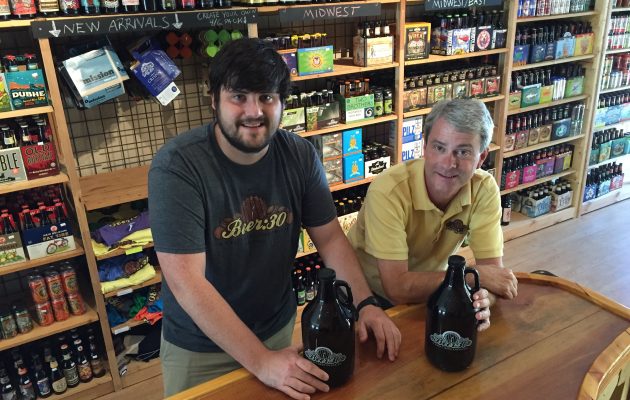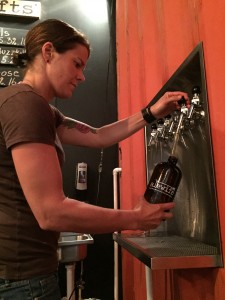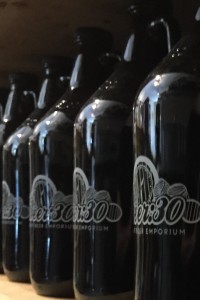Three-year growler fight prevails over decades-old ban

Of the 27 recent bills Governor Rick Scott signed, which went into effect July 1, 2015, only SB-186 induced a virtual beer buzz among its enthusiastic followers. This bill, three years in the making, rescinds a decades’ long ban on 64-ounce “growlers” – reusable glass containers resembling cider jugs – used to transport fresh beer from a brewpub or taproom to off-site locations.
Advocates for the new law thought it ludicrous that two 32-ounce growlers, or a 128-ounce (one gallon) size, were legal, but 64 ounces was not. This made it inconvenient for out-of-state visitors to have their 64-ounce containers filled.

Kelly Pickard, owner of Alewife Craft Beer Bottle Shop and Tasting Room, fills a 32-ounce growler with beer.
Filling two 32-ounce growlers might suffice, but, as Kelly Pickard, co-owner of Alewife Craft Beer Bottle Shop and Tasting Room in Riverside said, “Approach it from the consumer’s point of view. You (Floridians) could get two 32s or a gallon, but other people from other states couldn’t use a standard 64-ounce growler.”
According to Kevin Burns, co-owner/operator of Beer:30 in San Marco, favoring a 64-ounce container also improves portion and waste control. “It’s the perfect size for two people for two beers each. Thirty-two ounces is not enough and 128 is too much.” Sixty-four-ounce growlers are “more efficient. Every time you fill a 32, there is waste…64s reduce waste,” said Burns, who was referring to foam that accumulates and spills, more so for the smaller containers.
Florida’s new law also helps resolve cost inefficiency. Preben Olsen, co-owner of Aardwolf Brewing Company in San Marco, explained, “The price per unit (32- or 128-ounce) is more expensive because they’re considered irregular. No one (from out of state) is bringing a 32-ounce growler, and they would have to purchase one and not use it at home. It was a big turn-off to visitors.”
Olsen praised the new bill as “great, and honestly better than expected,” partly because it removed an arcane measure requiring taprooms to prove themselves as promoting Florida’s tourism industry. Additionally, it “…allows smaller entrepreneurs to get into business. We have a lot of people taking beer home now,” said Olsen.
Susan Miller of Bold City Brewery in Riverside, a family-owned and operated company (unrelated to Miller Beer fame), echoes Olsen’s sentiments. She said with this new law, microbreweries can do beer tastings in grocery stores 10,000 square feet and above, and with this new avenue, small brewers have a real opportunity for new business to flow.
Bold City Brewery and other microbrewers in Florida pushed for SB-186 through the Florida Brewers Guild. Coupled with helpful work by lobbyist and attorney Joshua D. Aubuchon, of Tallahassee, microbreweries and taprooms may now enjoy new business afforded by the law’s clarity and freedoms.
Growler history lesson
 Tomato and leaf-lard cans served beer hauling duties in the mid-late 1800s until replaced with tin buckets – both lidded and lidless – for ease of transport. “Working the growler” described both the pub trips to fill and to consume from a growler. For those unable to make a pub run, “rushing the growler” – sending children out for the task – was the thing to do.
Tomato and leaf-lard cans served beer hauling duties in the mid-late 1800s until replaced with tin buckets – both lidded and lidless – for ease of transport. “Working the growler” described both the pub trips to fill and to consume from a growler. For those unable to make a pub run, “rushing the growler” – sending children out for the task – was the thing to do.
However, the growler’s popularity and use faded with the advent of Prohibition and more convenient ways of beer bottling and transport.
In 1989 everything changed. Charlie and Ernie Otto, founders of Otto Brothers Brewing Company in Wilson, Wyoming, believed that their pure, hand-crafted beer had a place in the markets, but needed a way to transport their craft brews.
Responding to interview questions via email while traveling overseas in Switzerland, Charlie Otto explained how growlers moved from tin pails to their modern, silk-screen emblazoned glass form:
“It was really my father’s idea. We were a small micro-brewery and not bottling our products, and I told him folks at the bar were able to get our beer but not able to take it home. So he said that he remembered taking a metal pail, called a growler, to the bar to bring home fresh beer for his father.
“I bought some 64-ounce cider jugs and silk-screened our logo on them and, through a local retail store, started selling our beer to take home.
“I think there are still some great advantages of using a growler today, unlike throwaway bottles, where the glass is recycled; (with) the growler, the glass is reused, which is environmentally more sound. Also, it allows brewpubs that do not bottle or have very special, limited production products to sell these over the bar,” Otto said.
Miller offered fine praise for our local microbreweries, saying, “Jacksonville can be proud of its beer; everyone does a good job.”
Pickard happily noted, “It’s nice to not have conversations about how silly the old law was.”
Now residents can savor the 64-ounce victory.
By Vince Iampietro
Resident Community News






